Think of your car as a skilled acrobat, effortlessly gliding and navigating through life's obstacle course. Ever wondered what enables this graceful dance over the bumps and potholes, absorbing all the shocks to give you the perfect ride?
The answer lies within a vital automotive component known as car suspension. In this blog, we'll look into the kaleidoscopic world of car suspensions, demystify their mechanics, highlight their indispensability, and reveal the secrets to preserving their peak performance.
From the intricate choreography of the suspension system in automobiles to the synchronised ensemble of car suspension parts, join us on this journey to understand the craftsmanship that ensures not only a smooth ride, but also a secure one.
What Is a Car Suspension?

A car suspension functions as a crucial intermediary connecting your vehicle's body to its wheels. This intricate assembly consists of a collection of specialised parts with the primary purpose of delivering comfort, stability, and safety during your driving experience.
Regardless of whether you're driving along a well-paved highway or through rough and rugged terrains, the suspension system diligently undertakes the task of maintaining constant contact between your car's wheels and the road surface.
By effectively mitigating the impact of road irregularities, the suspension ensures that your ride remains as smooth and controlled as possible. This is instrumental in absorbing shocks caused by bumps, potholes, and other imperfections in the roads, thereby enhancing overall driving comfort and minimising wear and tear on both your vehicle and its occupants.
Types of Car Suspension Systems
The choice of the most suitable suspension system for a specific car hinges on several factors: the car's intended purpose, driving conditions, and the driver's preferences.
Different suspension systems address specific vehicle designs, performance needs, and load-handling capacities, exemplifying diverse engineering solutions that aim to create a harmonious and pleasant driving encounter.
Here are the main types of suspension systems:
1. Independent Suspension
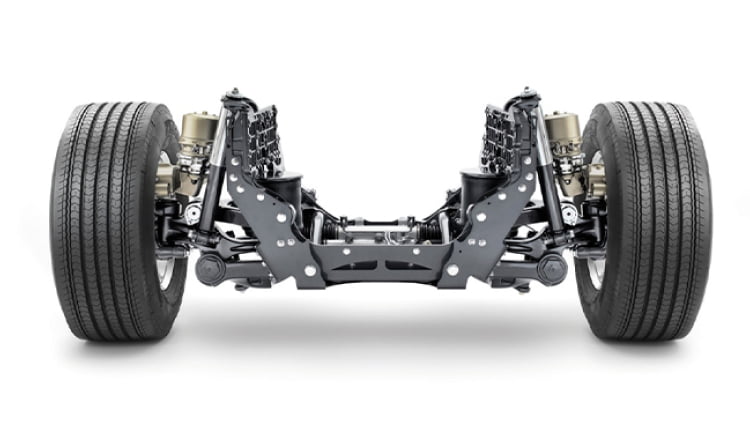
- Independent suspension allows each wheel to move independently, enhancing comfort and handling
- This is the most common type of suspension system used in modern cars
2. MacPherson Strut Suspension
- This is a type of independent suspension that is found in front-wheel-drive cars
- It is a simple and cost-effective design that provides good ride comfort and handling
3. Double Wishbone Suspension
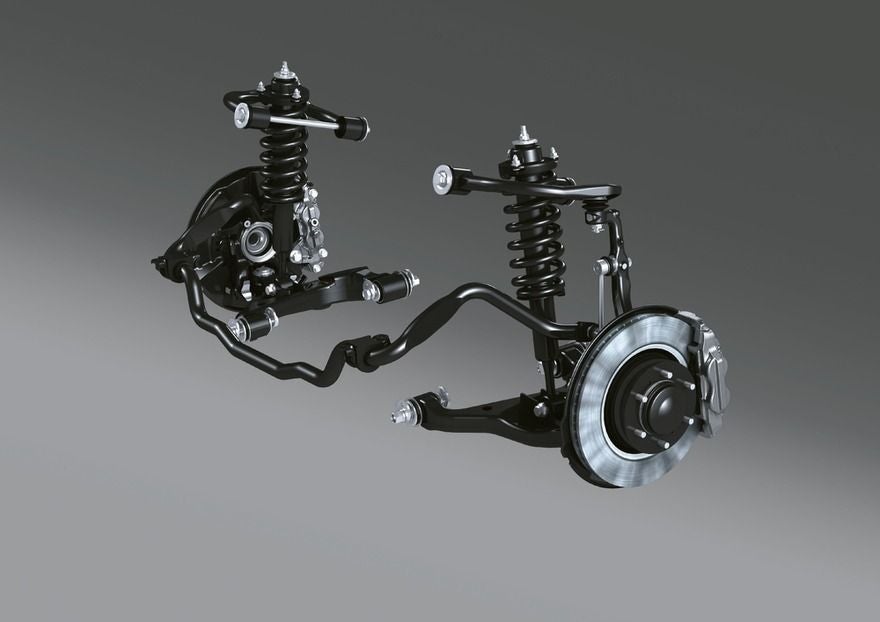
- This is a more sophisticated type of independent suspension that is found in rear-wheel-drive cars and performance cars
- It offers better handling and control than the MacPherson strut suspension
4. Multi-link Suspension

- This is the most complex type of independent suspension
- It uses multiple links and arms to provide precise control of wheel movement
- This type of suspension is found in luxury cars and high-performance cars
5. Dependent Suspension

- In this type of suspension, the wheel movement on one side affects the other, impacting ride comfort and handling
- This suspension is less prevalent today due to limitations in providing a smooth ride
6. Live Axle Suspension

- This is a type of dependent suspension that uses a solid axle to connect the wheels on each side of the car
- This type of suspension is found in rear-wheel-drive trucks and SUVs
7. Swing Axle Suspension
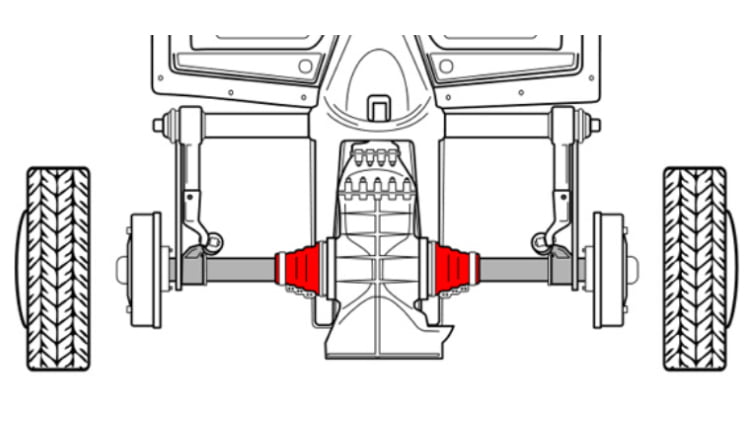
- This is a type of dependent suspension that is used in older vehicles, particularly rear-engine cars
- It features a single pivot point allowing the rear wheels to move up and down independently
8. Air Suspension
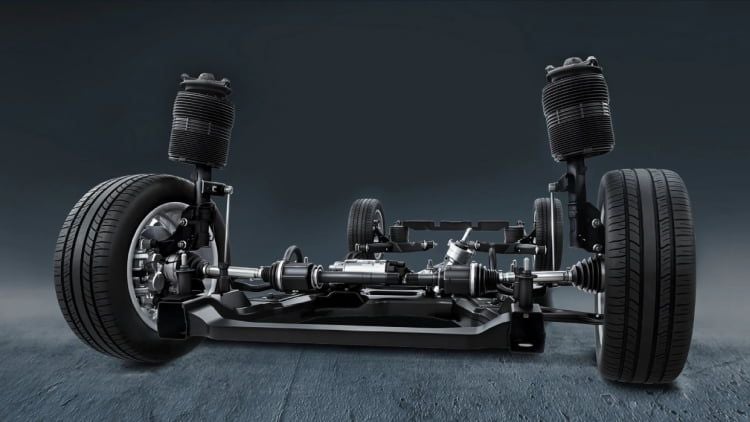
- Uses air-filled bags to replace traditional coil springs
- Adjustable and can vary ride height for improved comfort or performance
- Commonly found in luxury cars and SUVs
9. Leaf Spring Suspension
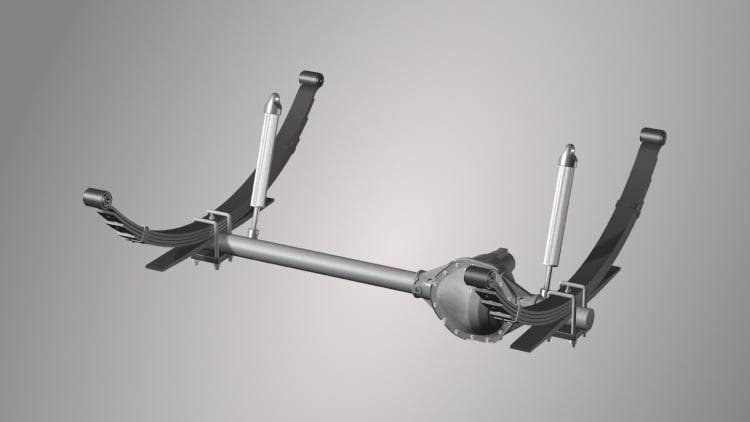
- Uses layers of metal strips (leaf springs) to support the weight of the vehicle
- Found in trucks, SUVs, and older cars
- Known for their durability and load-carrying capacity
How Does the Suspension System Work?
The suspension system is designed to absorb shocks and vibrations from the road. It is a critical component of a vehicle that helps provide a smooth ride and stable handling. It consists of several parts that work together to absorb shocks and bumps, ensuring that the wheels maintain contact with the road.
Some of the main components of a suspension system include:
- Springs
- These help absorb shocks and provide a comfortable ride by compressing and rebounding as the vehicle moves
- Shock absorbers
- These work alongside the springs to dampen the movement of the wheels and prevent excessive bouncing
- Struts
- These are similar to shock absorbers but also provide structural support for the suspension system
- Control arms
- These connect the suspension system to the vehicle's frame and help maintain the correct alignment of the wheels
- Ball joints
- These allow the wheels to move up and down while still maintaining their connection to the suspension system
Now that we know what comprises the suspension system, let's take a closer look at how it works:
- When a car hits a bump or rough road, the springs compress and absorb the shock
- The shock absorbers then help dampen the movement of the springs, preventing excessive bouncing
- The control arms and ball joints help maintain the correct alignment of the wheels, ensuring that they stay in contact with the road
- Struts provide additional structural support and help control the movement of the suspension system.
Role of a Car's Suspension System
A car's suspension is more than just a set of components; it's an ensemble of functions that collectively contribute to a smoother, safer, and more controlled driving experience.
Let's explore some of these functions in detail:
- Ride Comfort
- A properly working suspension system helps absorb the hiccups of the road, resulting in a comfortable ride for both passengers and the driver
- Stability and Handling
- The suspension system maintains the car's stability during turns and sudden changes in direction
- The enhanced control over the vehicle makes it safer for the occupants
- Traction
- By keeping the tyres in constant contact with the road, the suspension helps maintain traction
- This traction comes in handy during acceleration, braking, and cornering, amounting to an improved driving performance
- It also minimises wear and tear of the vehicle, thereby extending their lifespan and reliability
Why Is the Suspension So Important?
The suspension system in a car plays an important role in ensuring a smooth and safe ride. Without it, the impact of bumps, cracks, and potholes would directly reach the vehicle's body, making the journey uncomfortable and potentially hazardous.
A well-maintained suspension system is essential not only for passenger comfort, but also for preserving the structural integrity of the car. It absorbs shocks and vibrations, preventing them from affecting the overall performance of the vehicle. By maintaining proper tyre contact with the road, the suspension system improves traction, stability, and handling.
Here are some additional benefits of advanced suspension technologies:
- By reducing the amount of energy that is wasted in absorbing bumps and road irregularities, advanced suspension technologies can help improve fuel efficiency
- Advanced suspension technologies can help reduce noise and vibration inside the vehicle, making for a more comfortable and enjoyable driving experience
- By improving the handling and stability of the vehicle, advanced suspension technologies can help reduce the risk of accidents
Advanced Suspension Technologies
As technology advances, so do suspension systems. Some modern vehicles feature adaptive suspensions that adjust in real time based on driving conditions, enhancing both comfort and performance. These systems use sensors to monitor road conditions, vehicle speed, and more, making constant adjustments to deliver an optimal driving experience.
Here's a breakdown of some of the advanced suspension technologies:
1. Adaptive Suspensions
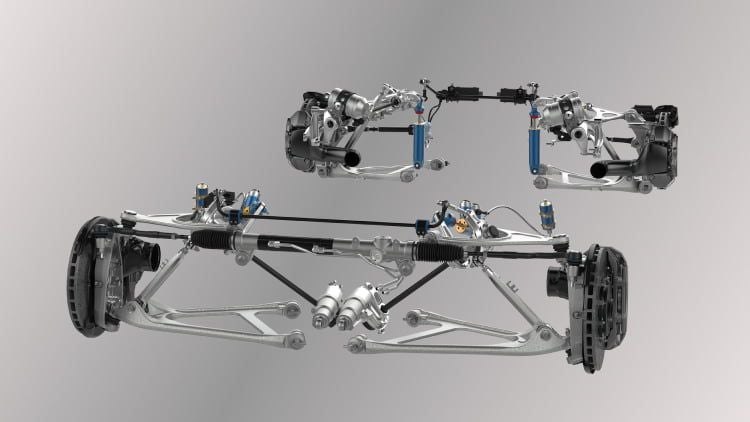
- These suspensions adjust in real time based on driving conditions, enhancing both comfort and performance
- Sensors monitor road conditions, vehicle speed, and other factors to make constant adjustments
- This can provide a smoother ride over bumps and rough roads, as well as better handling in corners and on uneven surfaces
2. Active Suspensions

- These suspensions use actuators to actively control the movement of the wheels, rather than relying on passive springs and dampers
- This can provide even more precise control over the suspension, resulting in a smoother ride and better handling
3. Semi-active Suspensions

- These suspensions use a combination of passive and active components to control the movement of the wheels
- This can offer a good compromise between comfort and performance while being less expensive than fully active suspensions
4. Electronically Controlled Suspensions
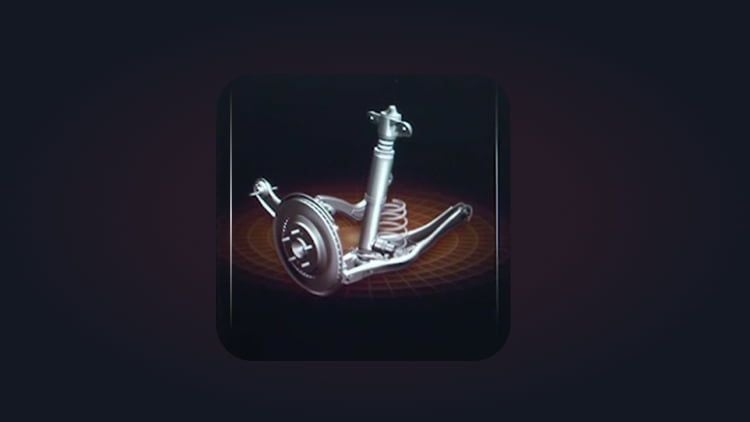
- These suspensions use electronic controls to adjust the settings of the suspension
- This can be done in real-time or pre-programmed for different driving conditions
How to Check Your Car's Suspension System
Maintaining a smooth and safe ride involves more than just the engine and tyres. Your car's suspension system plays a pivotal role, and ensuring its health is crucial.
Now, we'll walk you through some tips for checking your car's suspension system:
- Check for Leaks
- Look for any signs of fluid leaking from the shocks, struts, or control arms
- Check for Play (Excessive Movement in the Components)
- Use your hands to wiggle the wheels at each corner of the car
- There should be no more than a small amount of play
- Check for Uneven Tyre Wear
- Uneven tyre wear can be a sign of a problem with the suspension system
- Take Your Car for a Test Drive
- Pay attention to how the car rides and handles
- Any unusual noises or vibrations could be a sign of a problem
If you notice any of these problems, it is important to have your car inspected by a qualified mechanic as soon as possible. Early diagnosis and repair can help prevent more serious problems down the road.
Here are some tips on how to maintain the suspension system in your car:
- The frequency of inspection will depend on the driving conditions and the age of the car; it is a good idea to have your suspension system inspected at least once a year or every 20,000 kilometres
- Some common warning signs of a problem with the suspension system include a bumpy ride, squeaking, clunking, or rattling, uneven tyre wear, leaks, and difficulty controlling the car
- Worn suspension parts should be replaced as soon as possible to prevent further damage to the system and to ensure safe driving
- Shocks and struts should be replaced every 80,000-100,000 kilometres, depending on driving conditions
- It is important to use high-quality parts when replacing suspension components. This will ensure reliable performance and safety
- Wheel alignment should be checked and adjusted every 15,000-20,000 kilometres to prevent uneven tyre wear and bumpy rides
- Tyre pressure should be checked and adjusted regularly, according to the manufacturer's recommendations, as this supports the suspension system and prevents uneven tyre wear
- Overloading the car can strain the suspension system and accelerate wear
- Driving smoothly and avoiding rough terrains will help prolong the life of the suspension system
- If you are not comfortable checking your car's suspension system yourself, or if you suspect a problem, it is always best to consult a professional mechanic
The Bottom Line
When it comes to your car's performance, the suspension system plays an important role. Remember, a well-maintained suspension system is more than a technical requirement – it's your partner in navigating the unpredictable roads of life. So, take the time to inspect, care, and address issues promptly.
Whether it's the whisper of worn-out parts or the subtle jolt of uneven tyre wear, your car communicates its needs. You just have to pay attention to these cues, for they guide you towards a journey that's not only smooth and stable but also a testament to your safety and well-being.
FAQs
Q. How do I know if my car needs suspension?
You should watch out for signs like a bumpy ride, uneven tyre wear, or a drifting feeling while driving, as these could indicate suspension issues.
Q. What is a car suspension problem?
A suspension problem refers to any malfunction or issue with the components responsible for maintaining a smooth and stable ride.
Q. How does suspension affect the ride quality?
A well-functioning suspension system absorbs shocks and vibrations, ensuring a smoother and more comfortable ride.
Q. How often should I replace my car's suspension?
Suspension components can last for a long time, but they do wear out. If you notice any of the aforementioned signs, consult your car's manual or your mechanic for recommended maintenance intervals.
Q. How does suspension affect handling?
A good suspension enhances handling by keeping your tyres in contact with the road, providing better control during manoeuvres.
Q. How does suspension affect safety?
A properly functioning suspension improves safety by preventing loss of control, reducing wear on other parts, and maintaining stability during various driving conditions.














-(1).jpg&w=828&q=75)


.webp&w=828&q=75)
.jpg&w=828&q=75)






-(1).jpg&w=640&q=75)

.webp&w=640&q=75)
.jpg&w=640&q=75)









